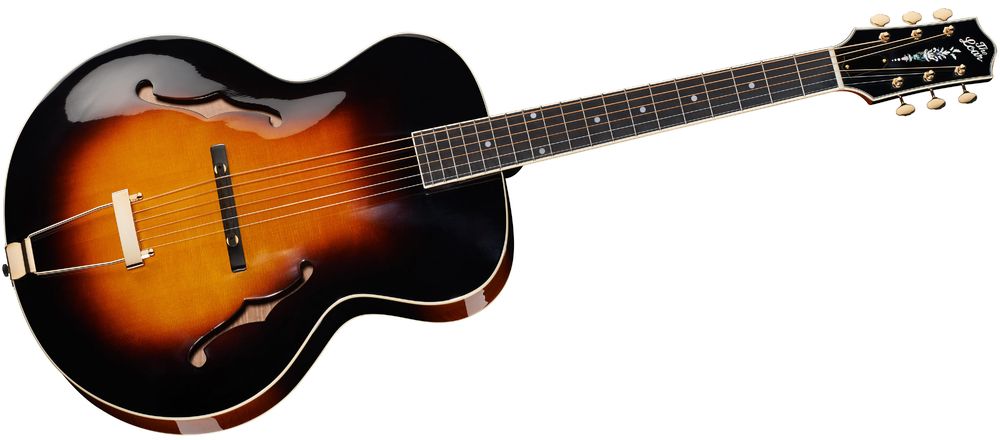7. Archtops
Dreadnought, Jumbo, OM, Flattop, Archtop - all terms that regularly come up when talking about acoustic guitars. But what exactly lies behind these flowery descriptions of different guitar body shapes remains a mystery for most guitarists. And that's not good because the body shape has a significant impact on the sound and, consequently, the preferred area of use for a guitar. In our online guide, we have compiled the most important information about the most common guitar body shapes and their respective sound/application areas. Let there be light!
The assortment can be broadly divided into two main groups: the so-called Flattops and the Archtop guitars. The term "Flattop" refers to all acoustic guitars with a flat top (the upper surface of the body). Archtops, on the other hand, have arched tops similar to classical stringed instruments. By the way, in the history of 20th-century guitar, Archtop acoustic guitars formed the basis for the development of jazz guitar.
Archtops
Orville had a brilliant idea. He wondered why guitars and mandolins had flat tops and backs, while their classical counterparts had beautiful carved, arched tops. So, he started experimenting with different prototypes, and guess what? He discovered that instruments with carved, arched tops and backs actually sounded way better than the ones with flat designs that were popular at the time. And when the first "Gibsons" hit the market in 1894, they sold like hotcakes, proving that Orville was onto something big.
Now, Gibson wasn't just focused on guitars—they were also masters at crafting top-notch mandolins. And when the mandolin boom happened in the early 20th century, Gibson became the top dog in no time. But they didn't stop there. They poured their heart and soul into guitar production too. One of their most successful models at the time was the L-1 (not to be confused with the flattop L-1 made famous by blues legend Robert Johnson).
The L-1 was a gem! It had a meticulously hand-carved arched spruce top and birch back and sides. The top was thin and bracing-free, so they added a maple plate below the bridge to handle the string tension. The neck was made of mahogany and had a comfortable, generous profile. Back then, they didn't have fancy steel reinforcements for the neck, so they had to make it thicker to handle the tension from the steel strings. Oh, and the scale length of the first L-1 was just under 57.8 cm, which helped alleviate some of the string tension.
Things really picked up when Gibson hired Lloyd Loar, a renowned mandolin virtuoso, as the head of their development department in 1919. Lloyd was the perfect guy to continue Orville's work, thanks to his practical experience. Under Lloyd's guidance, they created the F-5 mandolin and the legendary L-5 guitar (1923). The L-5 was a game-changer, packed with innovative features. It had a height-adjustable bridge and a floating-mounted fingerboard that allowed the top to vibrate more freely. Plus, it sported F-holes instead of the usual soundhole, which was a bold move.
Orville Gibson's dream of a guitar inspired by classical string instruments had finally come true. Thanks to star guitarist Eddie Lang, the L-5 took the world by storm. It became the first guitar to play a significant role in orchestras, replacing the tenor banjo as the go-to rhythm instrument.
In 1934, Gibson decided to give the L-5 even more power and make it a worthy competitor to the booming brass sections of jazz big bands. They increased the body volume and introduced the Super 400—a massive archtop with an 18-inch-wide body. It was the pinnacle of archtop design, but it also marked a turning point. They realized they couldn't keep making the body larger without sacrificing comfort and playability.
Inspired by Gibson's success, other manufacturers started producing guitars with arched tops and backs. Epiphone was one of the most successful ones, eventually merging with Gibson and setting new standards with models like the legendary Emperor.

As mentioned before, archtops were originally designed as purely acoustic guitars! However, the pursuit of increasing volume and the development of practical pickup systems, combined with the intensified use of archtops in jazz, led to the specialization of these "arched" guitars. As a result, both the L-5 and the Super 400 became hollow-body electric guitars, commonly referred to as jazz guitars by the people. This, in turn, led to the near extinction of fully acoustic archtops in the 1960s. Only a few small and very exclusive manufacturers continued to offer acoustic guitars with arched tops. And that remains the case to this day...






